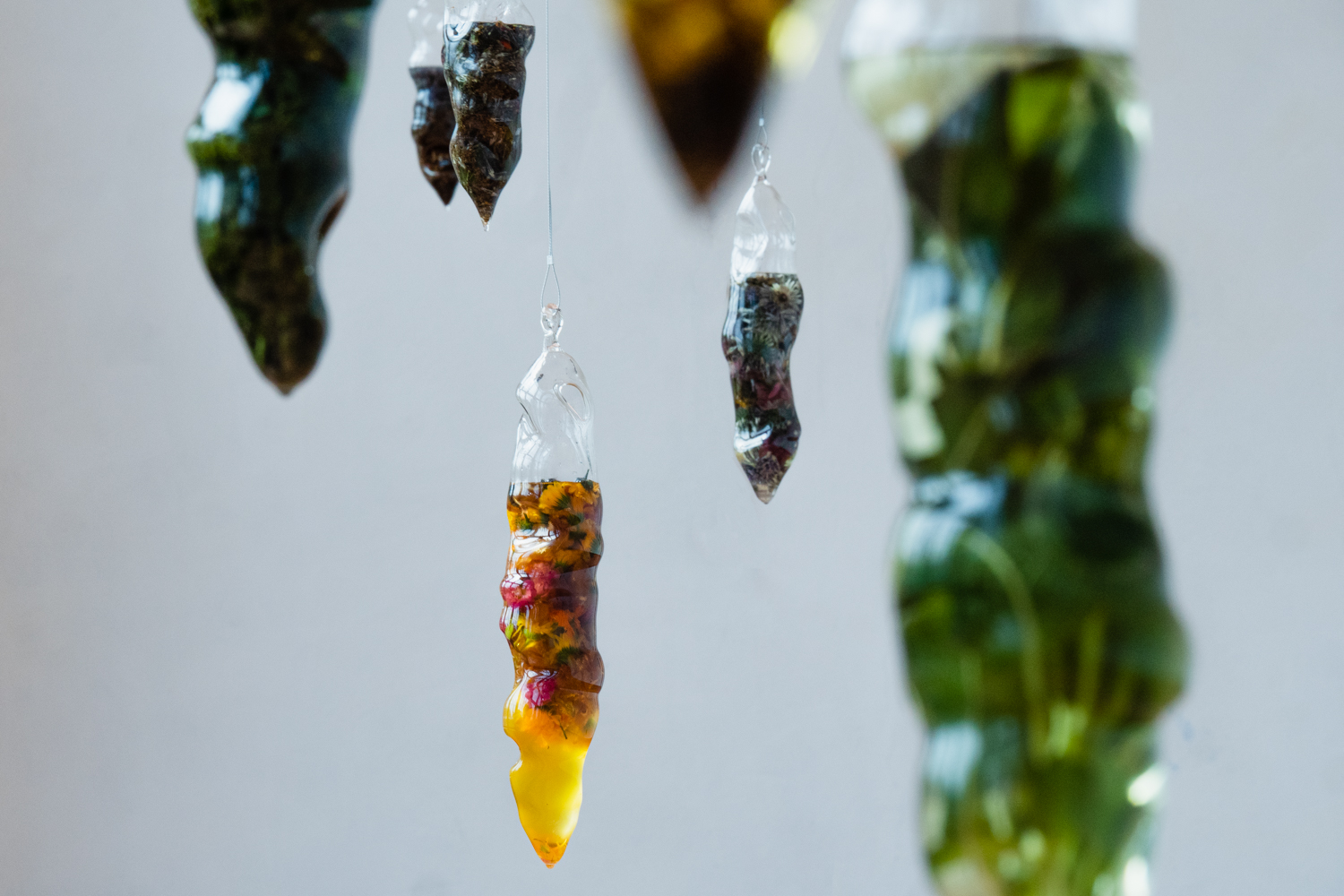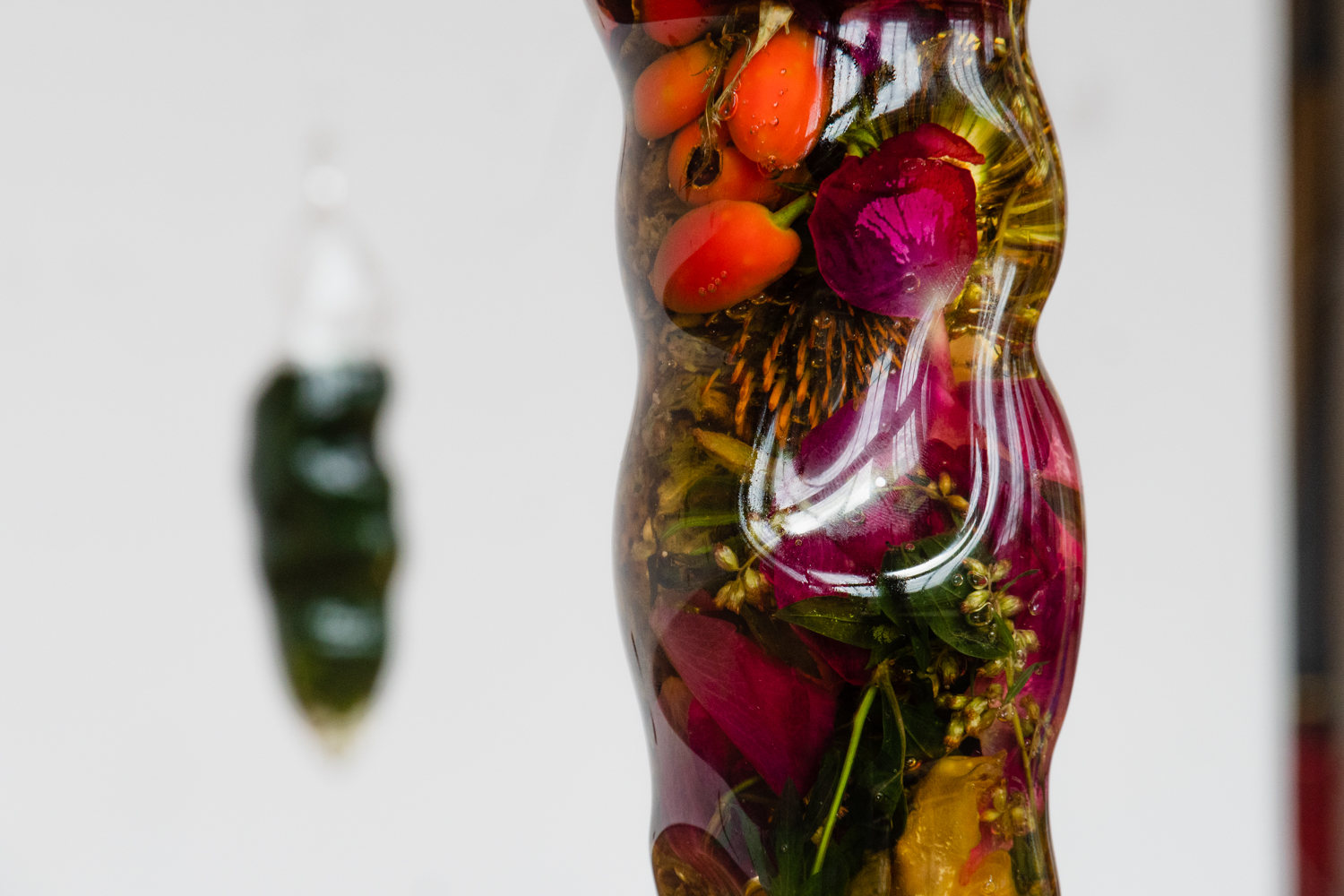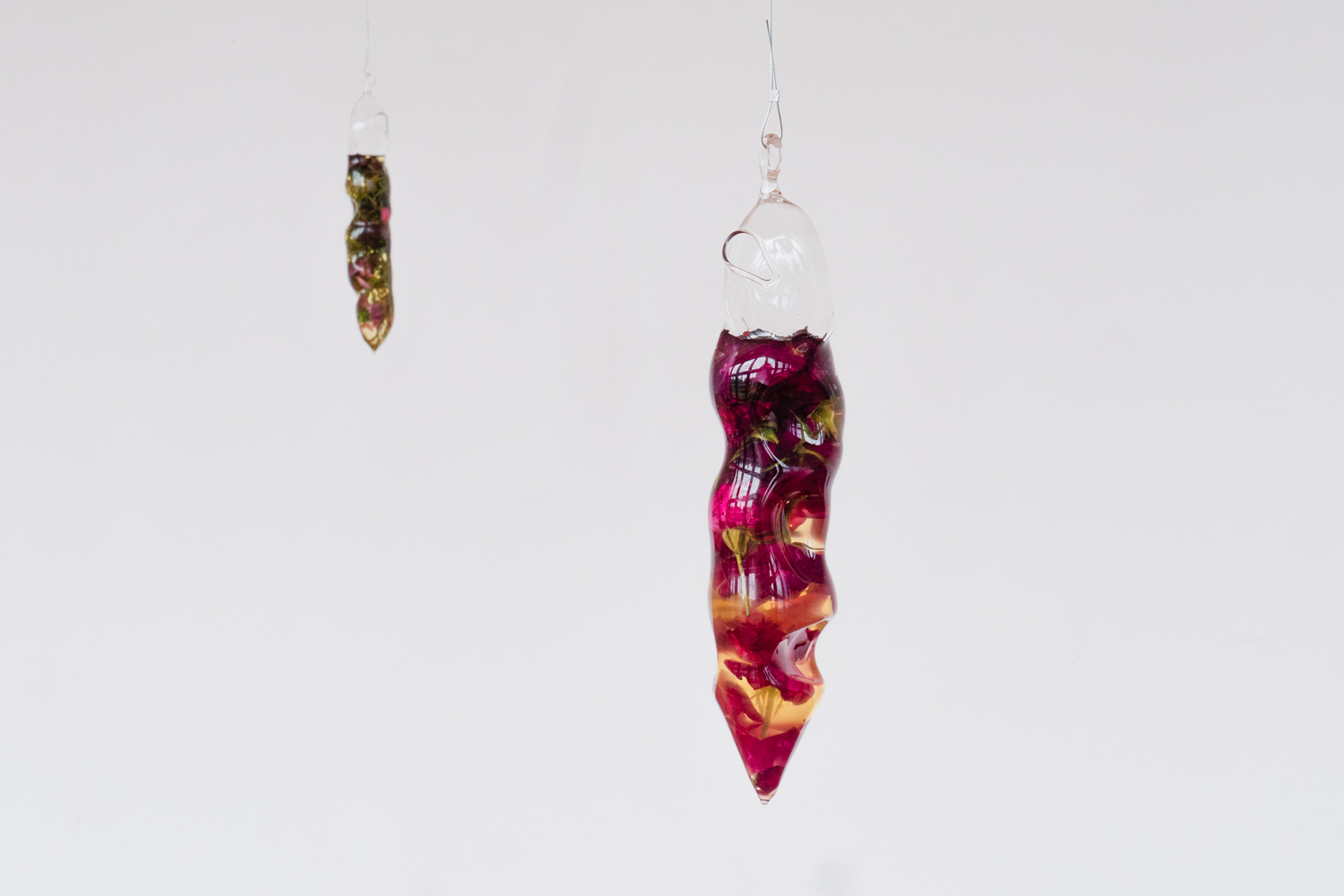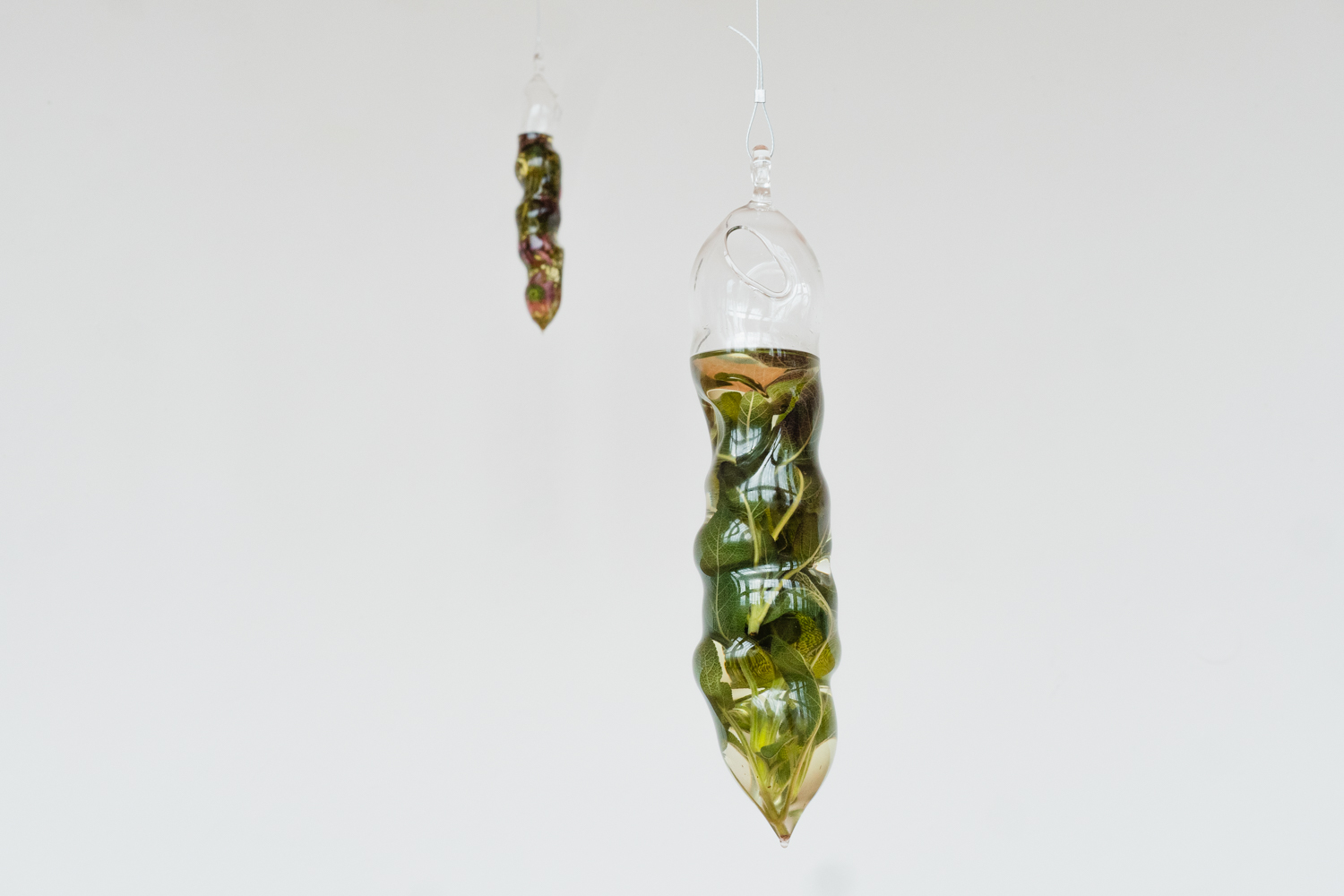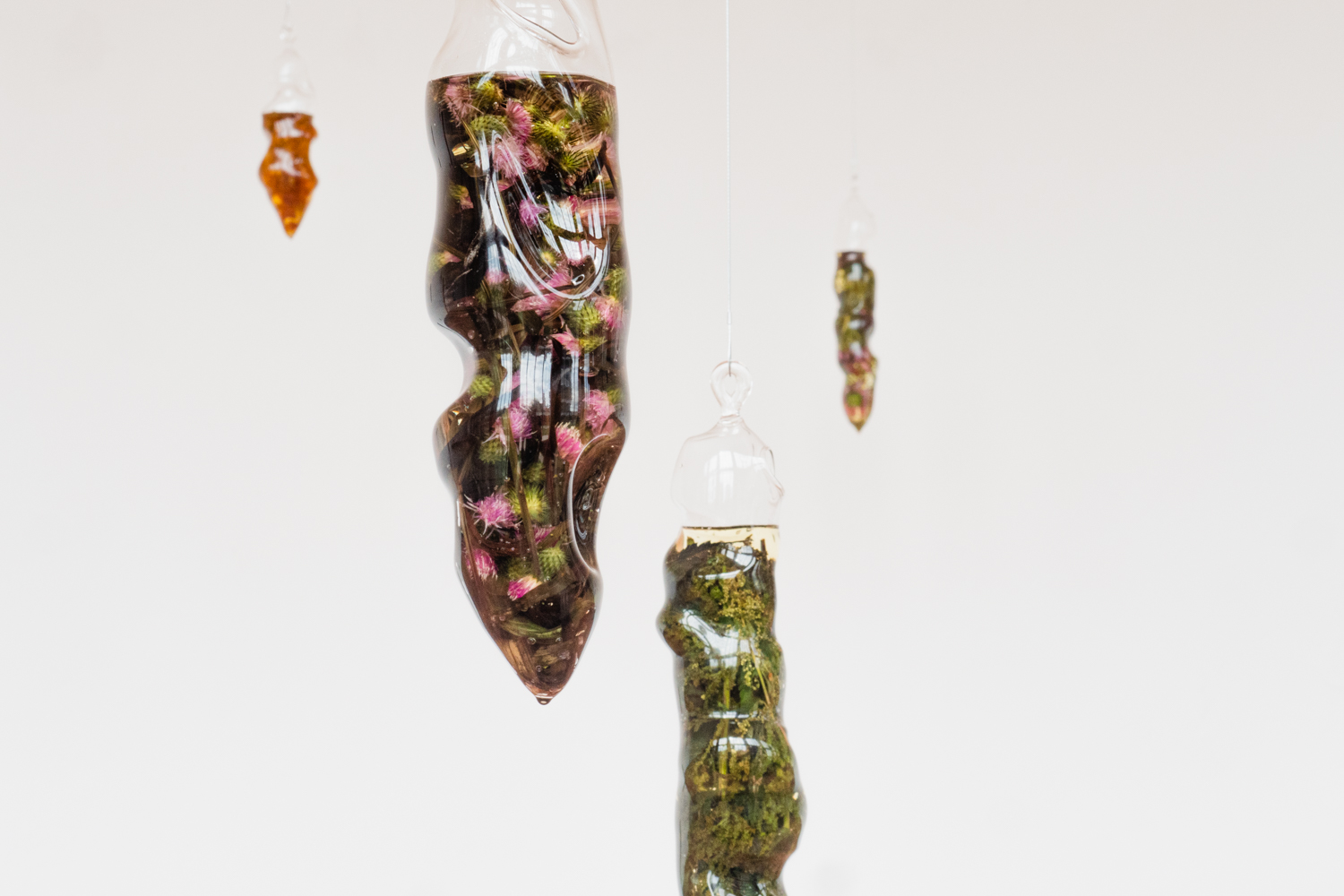Glacier Sunset
Miroslava and Vladimíra Večeřovy
14.08. – 26.09.21
This project, conceptualised by sisters Miroslava and Vladimíra Večeřovy, responds to the new long-term dramaturgy of Entrance Gallery, which has been focusing on the issues of ecological sustainability and the relationship between humans and the environment since 2020. The exhibition of the Večeřovy sisters reflects the specific season in which it takes place, summer and the time of harvest, with its pivot point being the processing of medicinal herbs through the traditional process of maceration (leaching in oil) that they employ. The installation, comprised of the authorial glass vessels, will develop and change over time as the macerate matures. The artists will then distribute the macerate to the visitors at the end of the exhibition. The exhibition project is an expression of the relationship with the gift of nature and its healing powers that both artists cherish.
During the opening night, we will also present a processual performance by the duo Stony Tellers, who will serve “critical drinks” to the visitors in the audience. The drinks will be mixed and customised for each visitor individually. In such a personalised process of mixing, Stony Tellers will use the ingredients they have grown in their community garden, whose rental and realisation has been supported by Entrance Gallery.
The Herbarium:
Urtica dioica, also known as stinging nettle or common nettle: Nettle significantly reduces joint pain. In addition, nettle has anti-inflammatory properties that are effective in the treatment of autoimmune diseases, such as rheumatoid arthritis.
Cannabis indica, also known as weed: Substances from hemp pulp relieve various kinds of pain, aid with stomach and digestive issues, increase appetite and have a general calming effect useful in treatments of sleeping disorders. Cannabis also reduces spasms and relieves muscle tension, a property employed in the treatment of Parkinson’s disease and multiple sclerosis. Cannabis seed extracts help in the prevention of cardiovascular disease and rheumatoid arthritis. They protect mucous membranes and can increase the production of breast milk.
Hypericum perforatum, also known as common St John’s wort or perforate St John’s wort: This queen of the so-called St John’s worts has always been considered to be a panacea — a remedy for all. Even the famous doctor and herbalist Pietro Andrea Mattioli wrote about its properties. As early as the 16th century, it was common to steep this herb in oils to brew decoctions and tinctures. The effects of the common St John’s wort have also been studied in detail by modern natural sciences, which have shown that it is a natural antidepressant.
Calendula officinalis, also known as the pot marigold, common marigold, ruddles or Scotch marigold: Calendula flowers are mainly used externally. Ointments are applied to poorly healing wounds, inflammation of the nail bed, tibial ulcers and are excellent prevention of nipple inflammation during breastfeeding. Internally, calendula is used as a gynaecological plant. It aids with irregular and painful menstruation, relieves menopausal difficulties, and suppresses gynaecological inflammations.
Origanum vulgare, also known as oregano: Oregano has a positive effect on the psyche. It has antispasmodic effects and can aid with neuroses. It is used to mitigate stress and insomnia. It is also effective as a treatment of migraines. It tends to improve digestion as it increases the expulsion of bile, while also helping in the treatment of internal infections and intestinal disorders, counteracting diarrhoea as well.
Verbascum densiflorum, also known as the dense flower mullein: The dense flower mullein is one of the oldest medicinal plants. In ancient times it was enwrapped in superstition, but even then it had been used for bronchial and lung ailments. It is still used exclusively for these purposes. It loosens phlegm, heals mucous membranes, clears bronchial passages, aiding with hoarseness and wheezing. It helps with bronchitis and laryngitis, relieving irritation of the upper respiratory tract. For these reasons, it is a crucial component of my cough tea blends.
Lavandula angustifolia, known as lavender, true lavender, English lavender, garden lavender, common lavender, and narrow-leaved lavender: Lavender is a wonderful herb that aids in case of a lack of appetite, irritated stomach, viral or inflammatory infections. It helps to lower blood pressure and can help relieve itchy cuts and insect bites. It also helps with sleep problems and nervousness and eases muscle tension.
Rosa canina, also known as dog rose: The flower cures diarrhoea helps with coughs and can be used as a gargle for sore throats. It positively adjusts the intestinal microflora after antibiotic use. It helps with heavy menstruation and strengthens the liver and nerves. Overall, dog rose calms and harmonises. Rose hips are used for the prevention and treatment of colds, flu infections and fever. As a source of vitamin C, it helps with its deficiency, aiding in the process of convalescence or with general fatigue.
Echinacea purpurea, also known as eastern purple coneflower, purple coneflower, hedgehog coneflower, or echinacea: As a natural antibiotic, echinacea helps destroy bacteria and viruses in the body. It significantly stimulates the activity of the cells of the immune system and promotes the production of natural antiviral substances called interferons. Native Americans are said to have used the plant internally to treat poisoning, such as rattlesnake bites.
Mentha piperita, also known as peppermint: Peppermint is a strongly aromatic plant that stimulates the production and secretion of bile, relieving bloating and cramps throughout the body. It also has anti-inflammatory effects that help establish an equilibrium in sebum production and fight acne.
Salvia officinalis, also known as the common sage or just sage: Sage can be used for inflammation of the oral cavity and larynx as a gargle, or internally to relieve night sweats and possibly treat digestive problems of inflammatory nature.
Artemisia cana, also known as silver sagebrush, sticky sagebrush, silver wormwood, hoary sagebrush, and dwarf sagebrush, and Artemisia ludoviciana, also known as silver wormwood, western mugwort, Louisiana wormwood, white sagebrush, and grey sagewort: vWormwood supports appetite and stimulates normal kidney and prostate function. Women also appreciate its benefits before and during menstruation.
Plantago lanceolata, also known as ribwort plantain, narrowleaf plantain, English plantain, ribleaf, lamb’s tongue, and buckhorn: Plantain contains mainly mucilaginous substances that loosen mucus and regulate stool. It is used for gynaecological ailments. Fresh juice from the leaves is used for insect stings, as it relieves unpleasant burning and greatly reduces swelling.
Rosmarinus officinalis also known as rosemary:It stimulates blood circulation, relieves tired and aching muscles. It has stimulating, antiseptic and healing effects, that relieve pain, reducing inflammation and strengthening the immune system. It aids in the treatment of headaches and migraines.
Carduus acanthoides, also known as spiny plumeless thistle, welted thistle, or plumeless thistle:Thistle is used internally especially in the treatments of diarrhoea and abdominal cramps, but also of kidney and urinary tract diseases. It also helps with colds and coughs. Externally, it is used to heal wounds. Poultices can be used to improve the condition of skin affected by certain types of eczema or psoriasis.
Perovskia atriplicifolia, also known as Russian sage:Russian sage soothes an upset stomach, helps with flu and colds or can be used to wash out wounds.
Echinops ritro, also known as the southern globethistle:It improves blood circulation and is suitable for the mitigation of the consequences of strokes. It helps to restore neural connections and aids in the restoration of mobility after severe injuries. It slightly dilates blood vessels, increasing the secretion of certain organs and lowers blood pressure.
This exhibition is supported by The Union for the Protection of Authorship GESTOR.

The exhibition program of Entrance Gallery is continuously supported by: Magistrát hl. města Prahy, The Ministry of Culture of the Czech Republic and MČ Praha 6.

